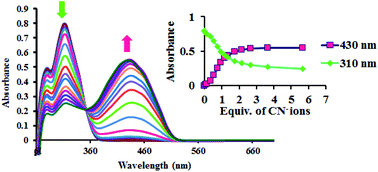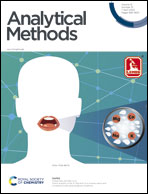Detection of CN−, Cu2+ and Zn2+ ions using a new chromone-based colorimetric chemosensor: half-adder and integrated circuits†
Abstract
In this study, a new chromone-based azomethine chemosensor, L, was designed, synthesized and characterized spectroscopically. Successfully, the chemosensor L was used to detect and recognize Cu2+, Zn2+ and CN− ions both visually and spectro-photometrically. The 1 : 1 binding stoichiometry between the mentioned ions and L was confirmed by a continuous variation titration method. Moreover, the detection limits of Cu2+, Zn2+ and CN− ions are 5.50 × 10−7, 8.70 × 10−7 and 1.56 × 10−6 mol L−1, respectively, which are lower than the permissible level recommended by WHO for safe drinking. The significant changes in the UV-visible spectra in the presence of Cu2+ and CN− ions, as two variable inputs, prompted us to conduct AND and XOR operations of half-adder circuits on one single substrate. On the merits of devised sensory systems, 2 bit Boolean binary logic functions such as OR and NOR gates were also elaborated. Expectedly, the individual logic gates including AND, OR, INH and NOR can be brought together through the combinatorial and complex three-input operations to function as integrated logic circuits utilizing Cu2+, CN− and Zn2+ as chemical inputs.



 Please wait while we load your content...
Please wait while we load your content...